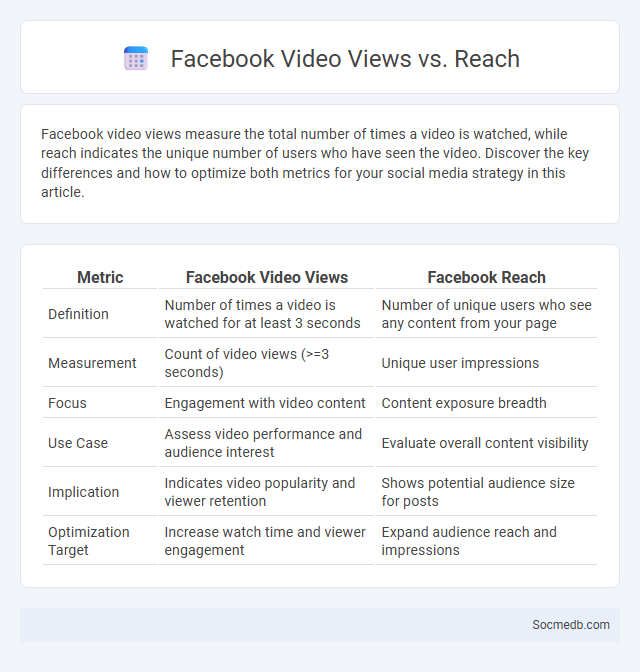
Photo illustration: Facebook Video Views vs Reach
Facebook video views measure the total number of times a video is watched, while reach indicates the unique number of users who have seen the video. Discover the key differences and how to optimize both metrics for your social media strategy in this article.
Table of Comparison
| Metric | Facebook Video Views | Facebook Reach |
|---|---|---|
| Definition | Number of times a video is watched for at least 3 seconds | Number of unique users who see any content from your page |
| Measurement | Count of video views (>=3 seconds) | Unique user impressions |
| Focus | Engagement with video content | Content exposure breadth |
| Use Case | Assess video performance and audience interest | Evaluate overall content visibility |
| Implication | Indicates video popularity and viewer retention | Shows potential audience size for posts |
| Optimization Target | Increase watch time and viewer engagement | Expand audience reach and impressions |
Understanding Facebook Video Metrics: Views, Reach, and Video View
Facebook video metrics provide essential insights into content performance, with views indicating the total number of times a video has been watched for at least three seconds. Reach measures the unique users who saw the video, reflecting its potential audience size, while video view duration reveals how long viewers engage with the content on average. Monitoring these metrics helps optimize video strategies by identifying what resonates with audiences and boosting overall engagement through targeted adjustments.
What is Facebook Video Views?
Facebook Video Views represent the total number of times your videos on Facebook have been watched by users. This metric counts views that last at least three seconds, providing insights into the initial engagement and reach of your video content. Understanding Facebook Video Views helps you gauge the effectiveness of your social media strategy and optimize content for increased audience interaction.
Defining Facebook Reach: How Far Does Your Content Go?
Facebook reach measures the unique number of users who see your content, indicating its potential audience size and engagement level. It encompasses organic reach from followers, paid reach through ads, and viral reach via shares, helping you gauge how widely your message spreads across the platform. Understanding your reach allows you to optimize content strategy, ensuring your posts resonate more effectively with your target audience.
What Counts as a Facebook Video View?
A Facebook video view is counted when a user watches a video for at least three consecutive seconds, signaling genuine engagement with the content. Autoplay views are included only if the video is on screen and audible, while views lasting less than three seconds do not register. Metrics such as total views, unique views, and average watch time provide deeper insights into audience interaction and video performance.
Key Differences: Video Views vs. Reach vs. Video View
Video views measure the total number of times a video has been watched, reflecting overall engagement and content popularity. Reach quantifies the unique number of users who have seen your post or video, indicating audience size and exposure. Video view often refers to specific time thresholds (e.g., 3-second views) to assess the initial viewer retention and effectiveness of video content.
Why Video Views and Reach Matter for Your Facebook Strategy
Video views on Facebook significantly boost engagement rates, increasing the likelihood that your content will be shared and seen by a broader audience. Higher reach expands brand awareness, improving the potential for conversions and customer interaction. Facebook's algorithm favors videos with high view counts, enhancing your organic visibility and overall marketing effectiveness.
How Facebook Calculates Video Views and Reach
Facebook calculates video views by counting a view when your video plays for at least three seconds, ensuring short, accidental clicks don't inflate statistics. Video reach is measured by the number of unique users who have seen your video, providing insight into how far your content spreads across the platform. Understanding these metrics helps you optimize content strategy and enhance engagement effectively.
Interpreting Your Facebook Video Analytics
Interpreting your Facebook video analytics reveals valuable insights into viewer engagement, watch time, and demographic data, helping you optimize content strategy effectively. Monitoring metrics such as average watch duration, video retention rate, and click-through rate allows you to understand which parts of your videos resonate most with your audience. Leveraging these analytics enables you to tailor future videos to boost reach, increase interaction, and enhance overall performance on the platform.
Tips to Improve Both Video Views and Reach
Optimizing your social media videos with engaging thumbnails and compelling captions can significantly boost views and reach. Utilize hashtags strategically and post during peak user activity hours to enhance visibility and engagement. Consistently analyze your video performance metrics to tailor content that resonates with Your audience and drives sustained growth.
Choosing the Right Metric for Your Campaign Goals
Selecting the right metric for your social media campaign depends on clearly defined goals such as brand awareness, lead generation, or conversion. Metrics like reach and impressions effectively measure awareness, while click-through rates and engagement rates track audience interaction and interest. Conversion tracking and return on ad spend provide valuable insights for campaigns focused on sales and revenue generation.
 socmedb.com
socmedb.com